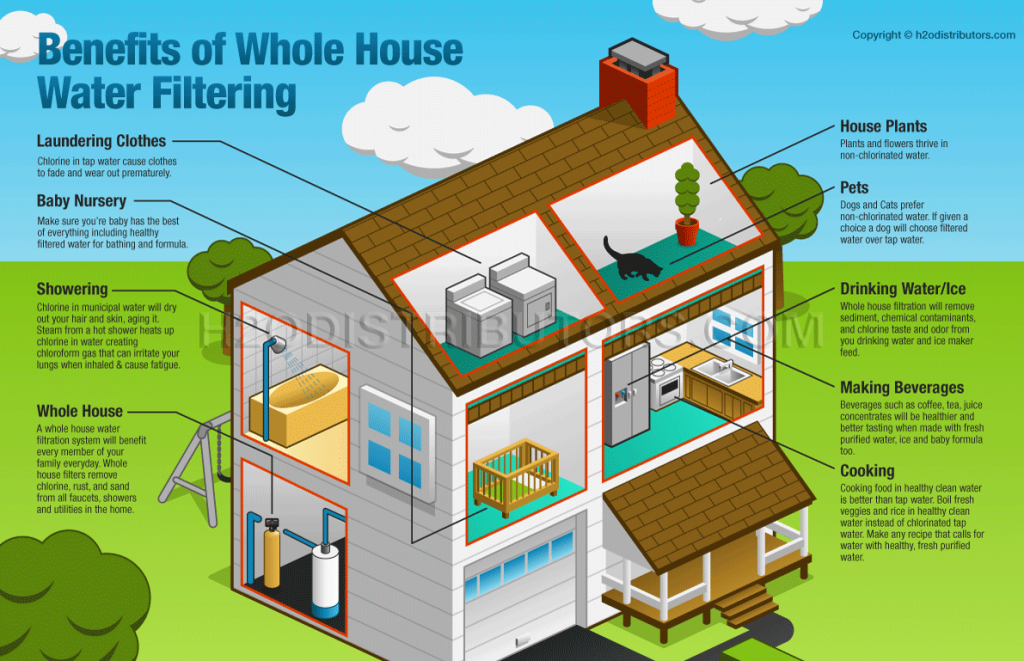Unlike city water, private well water doesn’t benefit from filtration and disinfection before it reaches your home. Well water doesn’t need to meet certain standards set out for public water supplies, either – but, of course, you’ll still want to make sure your drinking water is clean and safe to drink.
To eliminate common well water contaminants, such as sulfate, nitrates, iron, and coliform bacteria, you’ll need to install a well water treatment system. Water softeners, whole house water filters, disinfection systems and distillers are all effective options when it comes to eliminating the bad stuff from your well water.

Importance of Well Water Testing:
Wells collect untreated groundwater (surface water) that might contain a whole host of contaminants, some of them dangerous, and some of them less harmful but likely to affect the taste or smell of your water. The level of contaminants your water contains depends on your local area’s natural levels of minerals and impurities in the earth, and also whether an accident has occurred, such as ruptured septic tanks in your local area.
You must get into the habit of testing your well water, as you need to make sure that your water is consistently safe to drink. Getting your well water tested won’t only tell you if you’re drinking dangerous levels of a particular contaminant that has made its way into your surface water; it’ll also make you aware of high levels of aesthetic impurities, like hard water minerals and iron, which might damage your home’s pipes, plumbing, fixtures, and water-based appliances.
It’s best to get your well water tested by a state-certified laboratory, as recommended by the EPA. Contact your local laboratory to see if they offer any packages for testing for multiple well contaminants at once. A lab can help you to understand the level of impurities in your water and the problems they may cause.
Understanding Your Water’s Chemistry:
Understanding the characteristics of your well water – the combination of impurities that affect your water quality and pH – will help you to determine which water treatment solutions are best suited to your needs.
Some of the most important potential contaminants to test for in your well water include coliform bacteria, calcium and magnesium, lead, arsenic, iron, sulfate, nitrates, sediment, fertilizers, pesticides and herbicides, and VOCs. Varying levels of each of these impurities will cause various issues in your homes and require different forms of filtration or removal.
For instance, having high drinking water hardness problems means you’re best looking at a dedicated water softener, which will exchange hard water minerals with ions that are unable to form scale. If bacteria are the cause of issues in your drinking water, a disinfecting system, such as a UV system or a chlorination system, will be your best option.
For the removal of specific problem minerals or ions, such as sulfate or iron – which may be responsible for corrosion, affect water taste and odor and make household cleaning more difficult – you’ll be best looking at a whole-home well water filtration system or a reverse osmosis unit to treat the issue.
Understanding Water Pressure & Flow Rate:
The ideal water pressure for a well is between 40 and 60 PSI. A failing well pump or pressure tank could result in a decrease in pressure, so make sure to get your well inspected regularly for faults and problems, particularly if your water pressure is lower than desired.
Adequate water pressure is important whether you’re planning to install a well water treatment system or not – it’ll ensure that water can get around your home quickly enough and allow you to run multiple appliances at once. But when you have a water treatment system installed, it’s even more important that your water pressure is high enough, as sending water through a filter or resin will slow it down somewhat.
A poor flow rate may prevent a system from being able to work properly, especially in units that rely on fast flow, like reverse osmosis. Equally, if your water pressure is too high, your water treatment systems may be damaged by the force of the water against the filter media or resin.
Attaching a pressure gauge to your main water line will give you a fast and easy reading of your water pressure. If you do find that your pressure is inconsistent, installing a constant pressure system will prevent your pressure from drastically dropping when you’re using multiple appliances at once.
Types of Well Water Treatment Systems:
There are several types of well water treatment systems, each of which are suited for the removal of different contaminants in your water supply. These systems include:
1. Water Softeners:
A water softener is installed at your main water line for whole home use. One of the biggest aesthetic problems with private well water is hardness, which can form scale that has the potential to damage appliances and slows down water flow. Water softening systems tackle calcium and magnesium minerals, which are responsible for water hardness, and eliminate them from water.
There are two treated water softening options: salt (or sodium)-based water softeners and saltless softeners (conditioners). Salt-based softeners use the ion exchange process to swap hardness ions for harmless sodium ions, which prevents water from being able to leave scale deposits. Water conditioners don’t actually remove hardness minerals from private well water – they simply alter the composition of these minerals, without affecting water taste, so that they’re no longer able to stick to surfaces.
Some water softeners can also remove low levels of iron and sulfur, but if your well water has an abundance of these contaminants, it’s better using one of the suggested options below.
2. Whole House Filters:
Whole house water filtration systems usually consist of two tanks: one small tank to protect a sediment pre-filter and the larger of the tanks holding a related filter media that can effectively remove impurities that commonly enter a groundwater source, including iron, arsenic, nitrate, sulfate and heavy metals.
Typically, this type of whole house filtration system uses the oxidation process to effectively eliminate these common private well water contaminants. When well water flows through an air pocket, its sulfate, manganese and iron impurities oxidize. The filter media then traps the contaminants present, allowing only clean, filtered water to pass through. Every so often, the system will automatically backwash to remove the contaminants from the media bed.
Some whole-house treated water filters will also treat the presence of dissolved metal or chemical contamination with a carbon filtration stage, depending on what you opt for.
If your local well water supply contains a specific contaminant, such as manganese or sulfate, double-check that the well water filtration system you’re looking at is up for the job, as their exact capabilities vary from product to product.
3. Reverse Osmosis Systems:
Reverse osmosis filtration systems can either be installed to deliver water to your whole family or provide you with filtered tap water at your kitchen sink faucet. This kind of well water treatment system is considered one of the most effective for removing a broad range of contaminants that could pose a safety risk when present, from harmful bacteria to fluoride, heavy metals, arsenic, chemicals and more. With it being so universal, and with the option to install at a dedicated sink or your home’s point of entry, reverse osmosis is a fantastic option if you’re looking to tackle a broad range of contaminants in your private well water with one unit.
There are a number of filtration stages in an RO filter that can improve water quality – typically, water flows through a sediment filter and a carbon filter, which remove large impurities and aesthetic contaminants, improving water taste and smell. Reverse osmosis units also contain a semi-permeable membrane, which has tiny pores that act as a sieve, allowing only tiny water particles to pass through.
As expected, a reverse osmosis water filter is one of the most expensive water treatment systems for well owners, but for most people, the initial investment is worth it in the long run.
4. Chemical Disinfection Systems:
Chemical disinfection mimics the large-scale disinfecting process that takes place in municipal water treatment facilities. In this type of drinking water filter, a disinfectant (usually chlorine, ozone or chlorine dioxide) is injected in measured quantities into a water supply. Typically, a chemical disinfecting system will store water in a large tank, allowing the chemical enough time to disinfect water before it passes into your home.
This type of water treatment is fairly costly, but cheap and easy to maintain – you just need to make sure you replenish the chemical disinfectant when required. You may prefer not to use chemical disinfecting treatment systems if you’d rather you didn’t affect your water quality by introducing chemicals, though the amount of chemicals added isn’t enough to affect your health.
5. UV Disinfection Systems:
UV disinfection aims to achieve the same result as chemical disinfecting, but without the use of chlorine or a similar chemical. In UV disinfecting treatment, water flows through a chamber with a UV light. The ultraviolet rays produced by the light are capable of killing more than 99.9% of common microorganisms found in private wells that include viruses, disease-causing bacteria (like E. Coli), mold, yeasts and algae.
Most water filters for wells aren’t capable of removing microorganisms because they’re small enough to fit through the filter pores. Ultraviolet light, however, doesn’t filter these pathogens out of water – instead, it damages their DNA, killing them and preventing them from being able to duplicate.
Because ultraviolet water systems are naturally designed for targeting living, difficult-to-filter microorganisms in wells, they won’t remove or kill any other common contaminants that affect water quality. For that reason, many well owners combine separate UV disinfecting with a whole house water well filter or softening system for the best results.
Which Type of Treatment System Do I Need?
To determine which professional drinking water treatment system might be best for you, consider which contaminants you need to reduce or remove (water testing can help you if you don’t currently know what your well water contains), and your budget. Once you have a price range in mind, you can look for systems that are both affordable and effective in removing your targeted contaminants.
The bigger your budget, the more options you’ll have – but you don’t always have to spend a lot of money, especially if testing has revealed that you only have one or two problem contaminants in your well water. After you do your research, please call Roberts Plumbing, Inc. to professionally install your system if you’re not a DIY type of person.



